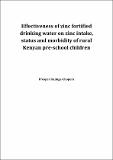Zinc bioavailability and elution rate from zinc fortified water produced by the Lifestraw® Family Filter
| dc.contributor.author | Prosper Kujinga, Valeria Galetti, Elizabeth Opiyo Anyango, Diego Moretti, Christophe Zeder, Adam Krzystek, Fabian Tay, Pauline Andang’o, Inge D Brouwer, Michael B Zimmermann, Félicien Tossou, Joseph D Hounhouigan, Michael B Zimmermann, Diego Moretti | |
| dc.date.accessioned | 2020-08-17T08:07:26Z | |
| dc.date.available | 2020-08-17T08:07:26Z | |
| dc.date.issued | 2016 | |
| dc.identifier.uri | https://repository.maseno.ac.ke/handle/123456789/2143 | |
| dc.description.abstract | Introduction: Zinc deficiency is a major public health problem in many developing countries. Zn fortification of foods may have limited impact because Zn bioavailability from staple foods is generally low. Fortification of drinking water with a stable, predictable concentration of fortificant at safe but adequate levels may be an alternative approach. Objectives (a) to compare bioavailability of zinc from fortified water consumed with or without zinc fortified maize in healthy adults (b) to investigate the effect of 3 simulated usage patterns and storage on zinc eluted into purified drinking water and (c) to compare expected enrichment levels with physiological requirements in children aged 1-6 years. | en_US |
| dc.publisher | Wageningen University/London | en_US |
| dc.subject | Zinc bioavailability and elution rate | en_US |
| dc.title | Zinc bioavailability and elution rate from zinc fortified water produced by the Lifestraw® Family Filter | en_US |
| dc.type | Article | en_US |

